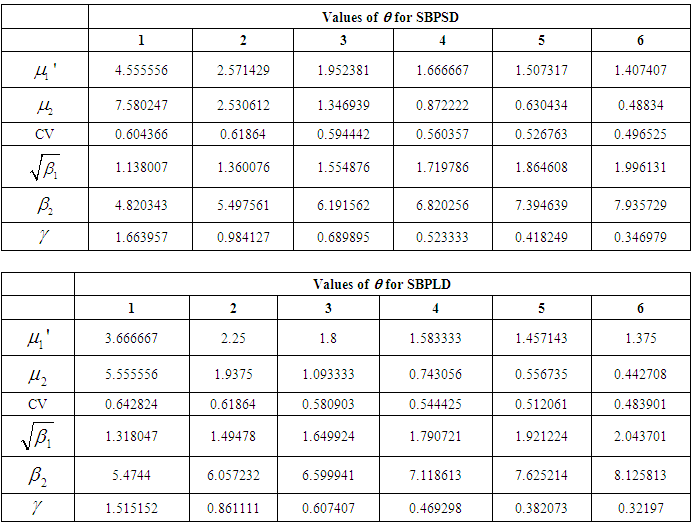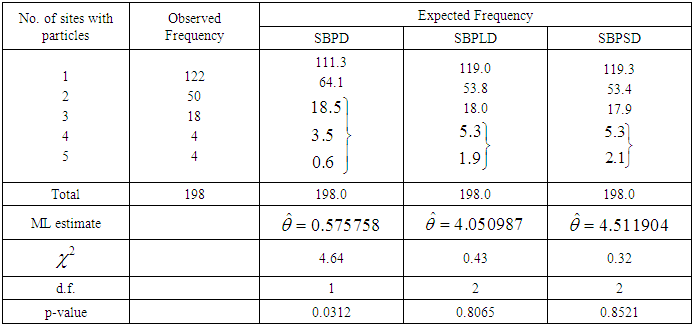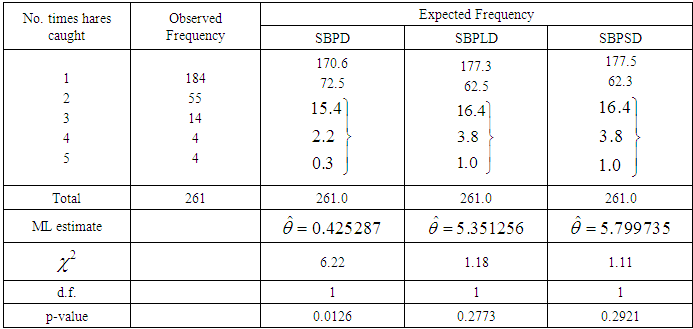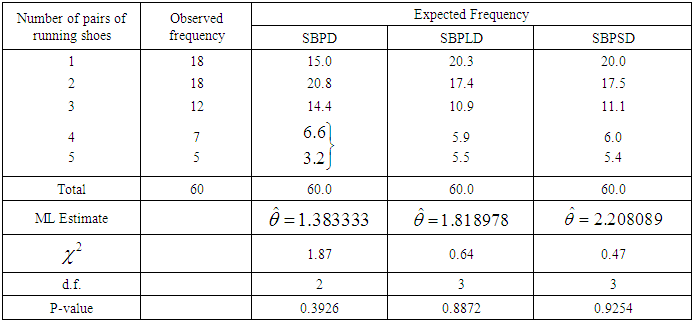-
Paper Information
- Previous Paper
- Paper Submission
-
Journal Information
- About This Journal
- Editorial Board
- Current Issue
- Archive
- Author Guidelines
- Contact Us
American Journal of Mathematics and Statistics
p-ISSN: 2162-948X e-ISSN: 2162-8475
2016; 6(4): 145-154
doi:10.5923/j.ajms.20160604.02

Size-Biased Poisson-Sujatha Distribution with Applications
Rama Shanker1, Hagos Fesshaye2
1Department of Statistics, Eritrea Institute of Technology, Asmara, Eritrea
2Department of Economics, College of Business and Economics, Halhale, Eritrea
Correspondence to: Rama Shanker, Department of Statistics, Eritrea Institute of Technology, Asmara, Eritrea.
| Email: |  |
Copyright © 2016 Scientific & Academic Publishing. All Rights Reserved.
This work is licensed under the Creative Commons Attribution International License (CC BY).
http://creativecommons.org/licenses/by/4.0/

A size-biased Poisson-Sujatha distribution (SBPSD) has been proposed by size-biasing the Poisson-Sujatha distribution (PSD) of Shanker (2016 b), a Poisson mixture of Sujatha distribution introduced by Shanker (2016 a). The first four moments about origin and moments about mean have been obtained and hence expressions for coefficient of variation (C.V.), skewness, kurtosis and index of dispersion have been given. The estimation of its parameter has been discussed using maximum likelihood estimation and method of moments. Three examples of real data-sets have been presented to test the goodness of fit of SBPSD over size-biased Poisson distribution (SBPD) and size-biased Poisson-Lindley distribution (SBPLD).
Keywords: Sujatha distribution, Poisson-Sujatha distribution, Size-Biasing, Moments, Estimation of parameter, Goodness of fit
Cite this paper: Rama Shanker, Hagos Fesshaye, Size-Biased Poisson-Sujatha Distribution with Applications, American Journal of Mathematics and Statistics, Vol. 6 No. 4, 2016, pp. 145-154. doi: 10.5923/j.ajms.20160604.02.
Article Outline
1. Introduction
- Size-biased distributions are a particular case of weighted distributions which arise naturally in practice when observations from a sample are recorded with probability proportional to some measure of unit size. In field applications, size-biased distributions can arise either because individuals are sampled with unequal probability by design or because of unequal detection probability. Size-biased distributions come into play when organisms occur in groups, and group size influences the probability of detection. Fisher (1934) firstly introduced these distributions to model ascertainment biases which were later formalized by Rao (1965) in a unifying theory for problems where the observations fall in non-experimental, non-replicated and non-random categories. Size-biased distributions have applications in environmental science, econometrics, social science, biomedical science, human demography, ecology, geology, forestry etc. Van Duesen (1986) has detailed study about the applications of size-biased distributions for fitting distributions of diameter at breast height (DBH) data arising from horizontal point sampling (HPS). Later, Lappi and Bailey (1987) have applied size-biased distributions to analyze HPS diameter increment data. The applications of size-biased distributions to the analysis of data relating to human population and ecology can be found in Patil and Rao (1977, 1978). A number of research have been done relating to size-biased distributions and their applications in different fields of knowledge by different researchers including Scheaffer (1972), Patil and Ord (1976), Singh and Maddala (1976), Patil (1981), McDonald (1984), Gove (2000, 2003), Correa and Wolfson (2007), Drummer and McDonald (1987), Ducey (2009), Alavi and Chinipardaz (2009), Mir and Ahmad (2009), Ducey and Gove (2015), are some among others.Let a random variable
 has probability distribution
has probability distribution  . If sample units are weighted or selected with probability proportional to
. If sample units are weighted or selected with probability proportional to  then the corresponding size-biased distribution of order
then the corresponding size-biased distribution of order  is given by its probability mass function
is given by its probability mass function where
where  When
When  the distribution is known as simple size-biased distribution and is applicable for size-biased sampling and for
the distribution is known as simple size-biased distribution and is applicable for size-biased sampling and for  the distribution is known as area-biased distribution and is applicable for area-biased sampling.The Poisson-Sujatha distribution (PSD) having probability mass function (p.m.f.)
the distribution is known as area-biased distribution and is applicable for area-biased sampling.The Poisson-Sujatha distribution (PSD) having probability mass function (p.m.f.) | (1.1) |
 follows Sujatha distribution introduced by Shanker (2016 a) with probability density function (p.d.f.)
follows Sujatha distribution introduced by Shanker (2016 a) with probability density function (p.d.f.) | (1.2) |
 can be obtained as
can be obtained as | (1.3) |
 is the mean of the PSD with p.m.f. (1.1).The p.m.f. of SBPSD can also be obtained from the size-biased Poisson distribution (SPBD) with p.m.f.
is the mean of the PSD with p.m.f. (1.1).The p.m.f. of SBPSD can also be obtained from the size-biased Poisson distribution (SPBD) with p.m.f. | (1.4) |
 follows size-biased Sujatha distribution (SBSD) with p.d.f.
follows size-biased Sujatha distribution (SBSD) with p.d.f. | (1.5) |
 | (1.6) |
 | (1.7) |
 are shown in figure 1.
are shown in figure 1. | Figure 1. Graphs of pmf of SBPSD and SBPLD for selected values of the parameter θ |
2. Moments
- Using (1.6), the
 factorial moment about origin of the SBPSD (1.3) can be obtained as
factorial moment about origin of the SBPSD (1.3) can be obtained as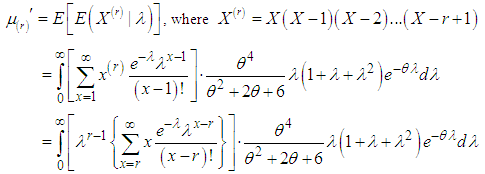 Taking
Taking  we get
we get Using gamma integral and a little algebraic simplification, the
Using gamma integral and a little algebraic simplification, the  factorial moment about origin of SBPSD (1.3) can be obtained as
factorial moment about origin of SBPSD (1.3) can be obtained as | (2.1) |
 in (2.1), the first four factorial moments about origin can be obtained and using the relationship between moments about origin and factorial moments about origin, the first four moments about origin of the SBPSD (1.3) are thus obtained as
in (2.1), the first four factorial moments about origin can be obtained and using the relationship between moments about origin and factorial moments about origin, the first four moments about origin of the SBPSD (1.3) are thus obtained as Now, using the relationship between moments about mean and the moments about origin, the moments about mean of the SBPSD (1.3) are thus obtained as
Now, using the relationship between moments about mean and the moments about origin, the moments about mean of the SBPSD (1.3) are thus obtained as The coefficient of variation
The coefficient of variation  coefficient of Skewness
coefficient of Skewness  coefficient of Kurtosis
coefficient of Kurtosis  and index of dispersion
and index of dispersion  of the SBPSD (1.3) are thus obtained as
of the SBPSD (1.3) are thus obtained as 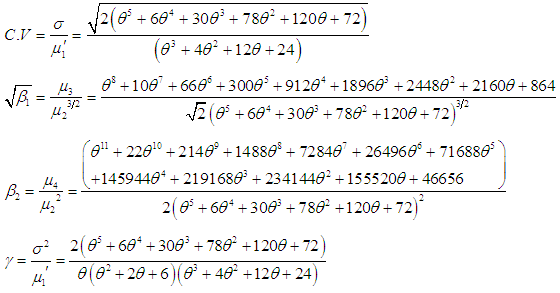 It can be easily verified that SBPSD is over-dispersed
It can be easily verified that SBPSD is over-dispersed  equi-dispersed
equi-dispersed  and under-dispersed for
and under-dispersed for  It should be noted that SBPLD is over-dispersed
It should be noted that SBPLD is over-dispersed  equi-dispersed
equi-dispersed  and under-dispersed for
and under-dispersed for  To study the characteristics of
To study the characteristics of  of SBPSD and SBPLD for various values of the parameter
of SBPSD and SBPLD for various values of the parameter  the numerical values of these characteristics have been presented in table 1.
the numerical values of these characteristics have been presented in table 1.
|
 coefficient of Kurtosis
coefficient of Kurtosis  and index of dispersion
and index of dispersion  of SBPSD and SBPLD are shown in figure 2
of SBPSD and SBPLD are shown in figure 2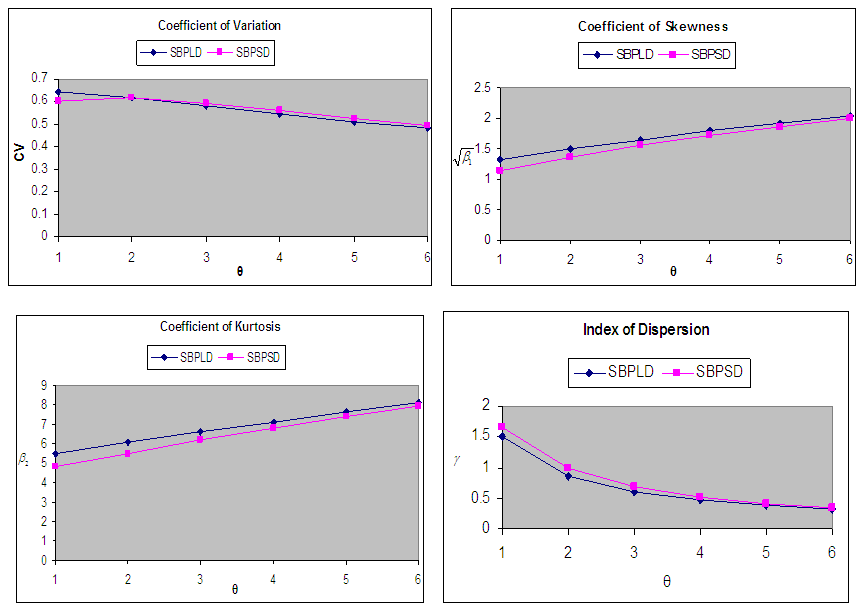 | Figure 2. Graphs of coefficient of variation (C.V), coefficient of Skewness  coefficient of Kurtosis coefficient of Kurtosis  and index of dispersion and index of dispersion  for SBPSD and SBPLD for selected values of their parameter θ for SBPSD and SBPLD for selected values of their parameter θ |
3. Properties of SBPSD
3.1. Unimodality and Increasing Failure Rate
- Since
 is a deceasing function of
is a deceasing function of  is log-concave. Therefore, SBPSD is unimodal, has an increasing failure rate (IFR), and hence increasing failure rate average (IFRA). It is new better than used in expectation (NBUE) and has decreasing mean residual life (DMRL). The definitions, concepts and interrelationship between these aging concepts have been discussed in Barlow and Proschan (1981).
is log-concave. Therefore, SBPSD is unimodal, has an increasing failure rate (IFR), and hence increasing failure rate average (IFRA). It is new better than used in expectation (NBUE) and has decreasing mean residual life (DMRL). The definitions, concepts and interrelationship between these aging concepts have been discussed in Barlow and Proschan (1981).3.2. Generating Function
- Probability Generating Function: The probability generating function of the SBPSD (1.3) can be obtained as
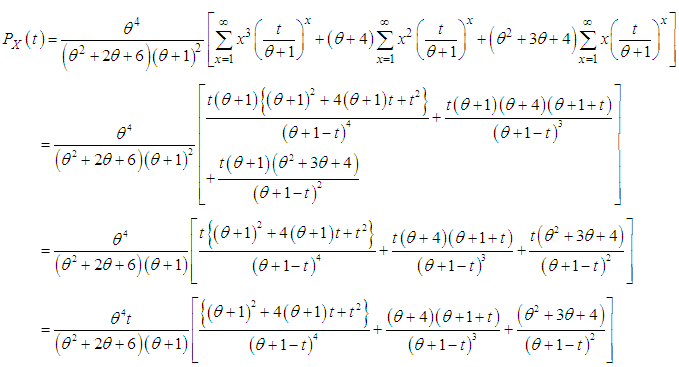 Moment Generating Function: The moment generating function of the SBPSD (1.3) is thus given by
Moment Generating Function: The moment generating function of the SBPSD (1.3) is thus given by
4. Estimation of the Parameter
4.1. Maximum Likelihood Estimate (MLE)
- Let
 be a random sample of size from the SBPSD (1.3) and let
be a random sample of size from the SBPSD (1.3) and let  be the observed frequency in the sample corresponding to
be the observed frequency in the sample corresponding to  such that
such that  where
where  is the largest observed value having non-zero frequency. The likelihood function
is the largest observed value having non-zero frequency. The likelihood function  of the SBPSD (1.3) is given by
of the SBPSD (1.3) is given by The log likelihood function can be obtained as
The log likelihood function can be obtained as The first derivative of the log likelihood function is thus given by
The first derivative of the log likelihood function is thus given by  where
where  is the sample mean.The maximum likelihood estimate (MLE),
is the sample mean.The maximum likelihood estimate (MLE),  of SBPSD (1.3) is the solution of the equation
of SBPSD (1.3) is the solution of the equation  and is given by the solution of the following non-linear equation
and is given by the solution of the following non-linear equation | (4.1.1) |
|
|
|
4.2. Method of Moment Estimate (MOME)
- Equating the population mean to the corresponding sample mean, the method of moment estimate (MOME)
 of
of  of SBPSD (1.3) is the solution of the following cubic equation in
of SBPSD (1.3) is the solution of the following cubic equation in 
 where
where  is the sample mean.
is the sample mean.5. Goodness of Fit
- In this section the goodness of fit of SBPSD, SBPLD and SBPD has been presented for three count data- sets. The fitting of these distributions are based on maximum likelihood estimates of the parameter. The first data-set is immunogold assay data of Cullen et al. (1990) regarding the distribution of number of counts of sites with particles from immunogold assay data, the second data-set is animal abundance data of Keith and Meslow (1968) regarding the distribution of snowshoe hares captured over 7 days, and the third data-set is number of counts of pairs of running shoes owned by 60 members of an athletics club, reported by Simonoff (2003).
6. Concluding Remarks
- A size-biased Poisson mixture of size-biased Sujatha distribution named, “size-biased Poisson-Sujatha distribution (SBPSD)” has been proposed by size-biasing the Poisson-Sujatha distribution (PSD) of Shanker (2016 b), a Poisson mixture of Sujatha distribution introduced by Shanker (2016 a). Its moments and other distributional properties including moments, coefficient of variation, skewness, kurtosis and index of dispersion have been studied. The estimation of its parameter has been discussed using maximum likelihood estimation and method of moments. Three examples of real data-sets have been presented to test the goodness of fit of SBPSD over size-biased Poisson distribution (SBPD) and size-biased Poisson-Lindley distribution (SBPLD).
ACKNOWLEDGEMENTS
- The authors would like to thank the Editor-In-Chief and the referee for careful reading and for their comments which improved the quality of the paper.
 Abstract
Abstract Reference
Reference Full-Text PDF
Full-Text PDF Full-text HTML
Full-text HTML for SBPSD and SBPLD for selected values of the parameter θ
for SBPSD and SBPLD for selected values of the parameter θ